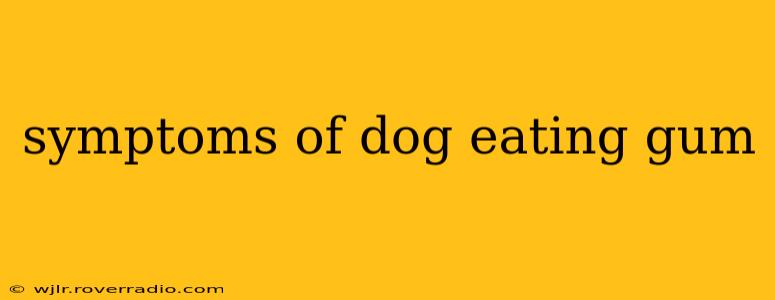Many dog owners unknowingly expose their furry friends to the dangers of chewing gum. While seemingly harmless to humans, many gums contain ingredients highly toxic to dogs. Understanding the symptoms of gum ingestion is crucial for swift and effective intervention. This guide will cover common symptoms and provide vital information on how to react if your dog has eaten gum.
What Happens When a Dog Eats Gum?
The primary danger in dogs eating gum lies in the presence of xylitol, an artificial sweetener increasingly common in sugar-free gum. Xylitol causes a rapid release of insulin, leading to a dangerous drop in blood sugar (hypoglycemia). This can manifest within minutes to hours of ingestion, and in severe cases, can lead to liver failure. Even small amounts of xylitol can be lethal to dogs, making it a significant threat. Beyond xylitol, other ingredients such as sorbitol (another sugar alcohol) can cause gastrointestinal upset.
Common Symptoms of Gum Ingestion in Dogs
The symptoms exhibited by a dog who has eaten gum can vary depending on the amount ingested and the specific ingredients present. However, some common signs to watch out for include:
- Weakness and Lethargy: Your dog may seem unusually tired or sluggish.
- Vomiting: This is a common response to a foreign substance in the digestive system.
- Diarrhea: Loose or watery stools are another indication of gastrointestinal distress.
- Tremors or Shaking: These can be a sign of hypoglycemia (low blood sugar).
- Seizures: In severe cases of xylitol poisoning, seizures can occur.
- Coma: This is a serious complication of severe xylitol poisoning.
- Loss of Coordination: Difficulty walking or maintaining balance.
How long after eating gum do symptoms appear?
The onset of symptoms varies greatly depending on several factors, including the amount of gum consumed, the dog's size and weight, and the specific ingredients. Symptoms related to xylitol poisoning often appear quite rapidly, within minutes to an hour, while other symptoms from other ingredients might take longer. It's crucial to monitor your dog closely after any suspected gum ingestion.
What are the first signs of xylitol poisoning in dogs?
The first signs of xylitol poisoning in dogs often include weakness, lethargy, vomiting, and loss of coordination. This is followed by a rapid drop in blood sugar, potentially leading to seizures and coma if left untreated. Immediate veterinary attention is vital if you suspect xylitol poisoning.
What if my dog ate sugar-free gum?
If your dog ate sugar-free gum, immediate veterinary attention is absolutely critical. Sugar-free gum often contains xylitol, a highly toxic artificial sweetener to dogs. Don't wait for symptoms to develop; contact your vet or an emergency animal hospital immediately.
My dog ate gum – what should I do?
If you suspect your dog has eaten gum, act quickly:
- Identify the type of gum: Try to determine if it was sugar-free (and if possible, the brand).
- Contact your veterinarian or emergency animal hospital immediately: Provide them with information on the type of gum, the amount ingested, and your dog's size and breed.
- Follow your vet's instructions: They may advise you to induce vomiting or bring your dog in immediately for treatment.
Preventing Gum Ingestion in Dogs
Prevention is always the best approach. To minimize the risk of your dog ingesting gum:
- Keep gum out of reach: Store gum securely, away from your dog's access.
- Supervise your dog around guests: Guests may accidentally drop gum.
- Train your dog not to eat things off the ground: This is a crucial command for all dog owners.
By understanding the symptoms of gum ingestion and acting promptly, you can significantly improve your dog's chances of a full recovery. Remember, prevention and swift veterinary care are key to ensuring your canine companion's health and safety.
